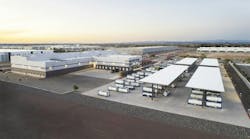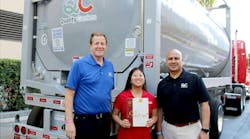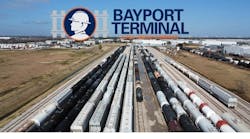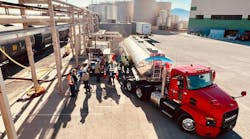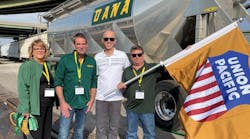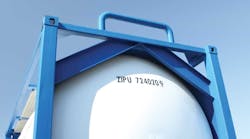JOHNSON Zhang, vice general manager and tank container engineer of CXIC Tianjin Xinhuachang International Containers Co, helped to establish a quality-control system specifically for tank manufacturing at CXIC and is accomplished in all international regulations and quality-control details regarding tank containers.
Zhang discussed the latest international tank container and quality control requirements during the Intermodal Tank Container Association’s 2016 Intermodal Bulk Liquid Symposium held October 7 in Kemah, Texas.
In his presentation on ISO tank containers, he said that an Initial Inspection Certificate must be in hand that includes the following information: manufacturer, owner, tank serial numbers, technical data, and all the registration codes needed to comply with regulations to ensure that tanks can travel with cargo all over the world.
Some of the regulations are focused on the tank frame strength:
• ISO Standard 1496/3, Part 3: Tank containers for liquids, gases, and pressurized dry bulk.
• TC (Transport Canada impact test).
• CSC (International Convention for Safe Containers).
• UIC (International Union of Railways).
• TIR (an international transport document allowing the transport of goods from the customs office of departure to the customs office of destination).
Zhang also pointed out that some of the standards are focused on the tank shell strength.
All of the following regulations specify the dangerous goods with UN numbers, listing the chemical properties and requirements in relation to storage and transportation:
• IMDG (International Maritime Dangerous Goods Code).
• ADR (the European agreement concerning the international carrying of dangerous goods by road).
• RID (regulations concerning the international carriage of dangerous goods by rail).
• US DOT (US Department of Transportation).
• UN recommendations on the transport of dangerous goods.
• ASME VIII, Div1 (specifies the welding procedure and quality standard of welding seam).
• The independent inspection authority (BV or LR).
He said the stacking test for ISO Standard 1496/3 confirms that the container can withstand the stacking force during the marine transportation. Also, considering the corner castings offset during the stacking, measurements are taken on the base and corner posts to determine elastic deflections and permanent set.
The top-lifting test for ISO Standard 1496/3 is intended to prove that containers can be lifted by their top corner fittings with the lifting forces applied vertically.
The bottom-lifting test is intended to prove that the container can be lifted by means of lifting devices bearing on the bottom corner fittings only and attached to a single transverse central spreader beam above the container.
IMDG identifies specific dangerous goods with UN numbers. If one kind of chemical product can be permitted to be transported by tank container, a suitable T code will also be specified.
• 6.7.2.4.2: The cylindrical diameter of shells can’t be more than 1.8m, and the reference steel thickness shall be not less than 5mm thick.
• 6.7.2.8.3: The relief device shall comprise a frangible disc preceding a spring-loaded, pressure-relief device. A nominal pressure 10% higher above the start to discharge pressure of the relief device.
• 6.7.2.6.2: Two closures are needed: one external stop-valve and a liquid tight closure at the end of the discharge pipe.
• 6.7.2.6.3: Three closures: Above two closures would be one more self-closing internal stop-valve.
• Not allowed: The T-code tank shall have no openings below the liquid lever of the shell.
Zhang said dynamic impact tests are performed pursuant to: CAN/CGSB-43.147:2005/AMD1; UN recommendations on the transport of dangerous goods (17th rev. ed. 6.7.2.19.1, Manual of Tests and Criteria, 5th rev. ed., Part IV Section 41); the International Standard ISO 1496-3:1995 AMD1 (2006); and DIN ISO 668:1999-10 regarding the difference K1 of diagonals D3, D4.
He said that according to the maximum gross weight of tank design, the test authority will set up a minimum shock response spectrum. After the impact test, the diagonal difference between sides should be not more than 10mm.
Of all the ISO tank containers, the T11 tank is the most popular in the market. Capacities range from 14,000 liters/3,699 gallons to 26,000 liters/6,869 gallons, and the tank is rated for four bar/58 psi.
On hydrogen peroxide tank containers (specified code is T14), a bottom outlet is not allowed. It is equipped with a big rupture disc and breather valve.
Solid particles tank containers are specially designed for loading bulk solids up to a table tennis ball size. When transporting to the destination, inject the suitable solvent, then discharge solution through the top valve with a syphon tube.
The super wide frame tank increases the capacity up to 28,300 liters/7,476 gallons and keeps the tank length within the standard 20 feet, but with a 2,550 mm width and 2,743 mm height.
The swapbody tank container used in Europe and other countries increases the tank capacity up to 36,000 liters/9,510 gallons. Maximum gross weight is 39,000 kilograms/85,980 pounds.
Other specialized regional equipment includes the railway frame tank used in China’s railway system. This type of tank also is recommended for use in the markets in India and Russia. It is constructed with a more robust frame.
Accessories:
• The ground operated handrail. Before the operator climbs to the top of the tank, the top handrail can be operated on the ground.
• Dipstick. Two options: hang in the side of the manhole or fixed in the spill box sidewall.
• Spill box lid. Recommended for tank containers handling foodgrade cargoes. ♦



